 W
WAdoration of the Christ Child, is a circa 1619–1621 oil on canvas painting of the Nativity by the Dutch Golden Age artist Gerard Honthorst in the collection of the Uffizi in Florence.
 W
WAdoration of the Christ Child is a tempera on panel altarpiece by Filippo Lippi, originally painted for the church of San Domenico in Prato and now in the city's Museo Civico. It is also known as Adoration of the Christ Child with St Vincent Ferrer or Nativity with St George and St Vincent Ferrer. It was painted between 1455 and 1466. The work was probably damaged by a fire in the church in 1467, requiring some repairs which were discovered in a recent restoration of the work.
 W
WAdoration of the Christ Child is an oil on panel painting produced in 1523 by Lorenzo Lotto and signed at the bottom right "L. Lotus / 1523". It is now in the National Gallery of Art in Washington.
 W
WThe Adoration of the Kings is an oil painting on panel of c. 1500 by Bramantino in the National Gallery, London. In it the Holy Family and the Magi are, unusually, joined by an adult John the Baptist, whose Baptism of Christ was celebrated on the same day as Epiphany in the liturgical calendar. The panel entered the National Gallery in 1916 as part of the Layard Bequest.
 W
WAdoration of the Shepherds is a c.1540 oil on canvas painting by Giovanni Gerolamo Savoldo, now in the Pinacoteca Tosio Martinengo in Brescia. It was one of the painter's last works and he also produced variants on it, including one in San Giobbe in Venice.
 W
WThe painting titled Madonna of the Cat or Madonna del gatto was painted in 1575 by Federico Barocci. It is presently in the National Gallery of London.
 W
WThe Mérode Altarpiece is an oil on oak panel triptych, now in The Cloisters, in New York City. It is unsigned and undated, but attributed to Early Netherlandish painter Robert Campin and an assistant. The three panels represent, from left to right, the donors kneeling in prayer in a garden, the moment of the Annunciation to Mary, which is set in a contemporary, domestic setting, and Saint Joseph, a carpenter with the tools of his trade. The many elements of religious symbolism include the lily and fountain, and the Holy Spirit represented by the rays of light coming through from the left hand window.
 W
WThe Presentation at the Temple is a painting of the Presentation of Jesus at the Temple by the Italian master Giovanni Bellini, dating to c. 1460. It is housed in the Fondazione Querini Stampalia, in Venice, Italy.
 W
WThe San Gottardo Altarpiece is an oil on canvas painting by Giovanni Cariani, previously dated to 1520 but now thought to have been begun in 1517 and completed in 1518. This made it perhaps his first major work and certainly the first work he produced in Bergamo after arriving there on 15 August 1517 - St Joseph was the city's patron saint. It was commissioned as an altarpiece by the council of the Scuola di san Giuseppe for the church of San Gottardo. There was tension between the commissioners and the artist and - instead of Cariani - they opted for Lorenzo Lotto and Previtali for the larger works in the church.
 W
WThe Census at Bethlehem is an oil-on-panel by the Flemish Renaissance artist Pieter Bruegel the Elder, painted in 1566. It is signed and measures about 115,5 cm × 164,5 cm. It is currently held and exhibited at the Royal Museums of Fine Arts of Belgium in Brussels, which acquired it in 1902. It is one of the first paintings in western art to feature a significant snow landscape and was painted in the aftermath of the winter of 1565, which was one of the harshest winters on record.
 W
WChrist in the House of His Parents (1849–50) is a painting by John Everett Millais depicting the Holy Family in Saint Joseph's carpentry workshop. The painting was extremely controversial when first exhibited, prompting many negative reviews, most notably one written by Charles Dickens. It catapulted the previously obscure Pre-Raphaelite Brotherhood to notoriety and was a major contributor to the debate about Realism in the arts.
 W
WThe Coronation of the Virgin Altarpiece is a c.1534 five panel work by Moretto da Brescia. Its central panel and upper panel are still in the church of Santi Nazaro e Celso in Brescia, whilst the two upper roundels and predella are in the same church's rectory.
 W
WThe Doni Tondo or Doni Madonna, is the only finished panel painting by the mature Michelangelo to survive. Now in the Uffizi in Florence, Italy, and still in its original frame, the Doni Tondo was probably commissioned by Agnolo Doni to commemorate his marriage to Maddalena Strozzi, the daughter of a powerful Tuscan family. The painting is in the form of a tondo, meaning in Italian, 'round', a shape which is frequently associated during the Renaissance with domestic ideas.
 W
WThe Dream of Saint Joseph is an oil on canvas painting created between 1628 and 1645 by the French Baroque painter Georges de La Tour which is now in the collection of the Musée d'Arts de Nantes.
 W
WThe Finding of the Saviour in the Temple (1854–1860) is a painting by William Holman Hunt intended as an ethnographically accurate version of the subject traditionally known as "Christ Among the Doctors", an illustration of the child Jesus debating the interpretation of the scripture with learned rabbis. The passage illustrated is from the Gospel of Luke, 2:41, which states:Every year his parents went to Jerusalem for the Feast of the Passover. When he was twelve years old, they went up to the Feast, according to the custom. After the Feast was over, while his parents were returning home, the boy Jesus stayed behind in Jerusalem, but they were unaware of it. Thinking he was in their company, they traveled on for a day. Then they began looking for him among their relatives and friends. When they did not find him, they went back to Jerusalem to look for him. After three days they found him in the temple courts, sitting among the teachers, listening to them and asking them questions. Everyone who heard him was amazed at his understanding and his answers. When his parents saw him, they were astonished. His mother said to him, "Son, why have you treated us like this? Your father and I have been anxiously searching for you." "Why were you searching for me?" he asked. "Didn't you know I had to be in my Father's house?" But they did not understand what he was saying to them.
 W
WMarriage of the Virgin or the Ginori Altarpiece is a 1523 oil on panel painting by Rosso Fiorentino, signed and dated by the artist. It was commissioned by Carlo Ginori for the chapel dedicated to the Virgin Mary and saint Joseph - previously owned by the Masi family that chapel had been acquired by the Ginori family in 1520. It still hangs in the Basilica, whilst a drawn copy attributed to Antonio Circignani is now in the Louvre (n.1592).
 W
WHoly Family with the Infant Saint John the Baptist is a c.1522-1523 oil on panel painting by Pontormo, produced early in his career. It now hangs in the Hermitage Museum, which acquired it with countess E. I. Mordvinova's collection. A preparatory drawing survives in the Uffizi's Gabinetto dei Disegni e delle Stampe.
 W
WJoseph the Carpenter is an oil painting by Georges de La Tour created circa 1642. The painting depicts a young Jesus with Saint Joseph, his earthly father.
 W
WJoseph's Dream is a 1620s painting by Daniele Crespi, now in the Kunsthistorisches Museum in Vienna. It shows an angel appearing to Joseph of Nazareth in his sleep to warn him of Herod the Great's intent to kill Jesus and to instruct him to flee into Egypt, the second of Saint Joseph's dreams in the Gospel of Matthew.
 W
WJoseph's Dream is a 1645 oil on canvas painting by Rembrandt. It was in the Königliche Schlöss in Berlin until 1830, when it moved to the city's Königliche Museum. It is now currently in the Gemaldegalerie, Berlin. It shows Saint Joseph receiving the second of his dreams warning him of the Massacre of the Innocents.
 W
WJoseph's Dream is a 1650-1655 oil on canvas painting by Barent Fabritius and other artists in Rembrandt's studio. It is now in the Museum of Fine Arts (Budapest), which purchased it in 1885 from Alois Hauser the Elder's collection in Munich. It had previously been auctioned in Amsterdam in 1755.
 W
WPresentation of Christ in the Temple is a small 1445 painting by the German artist Stefan Lochner, now in the Gulbenkian Foundation, Lisbon. It was once the wing of a diptych, the opposite, now separated, panel was a depiction of the Nativity. Its reverse shows the Stigmatisation of St. Francis. The panel is dedicated to St. Catherine and shows the purification of the Virgin. It is the first of two of Lochner's treatments of the subject - a larger painting completed two years later is kept at the Hessisches Landesmuseum, Darmstadt, Germany. The two panels are the only known dated paintings left by Lochner.
 W
WThe London Altarpiece or The Madonna and Child with Saints is a c.1540 oil on canvas painting by Moretto da Brescia, now in the National Gallery, London.
 W
WThe Madonna of Loreto is a painting finished around 1511 by the Italian High Renaissance painter Raphael. It is housed in the Musée Condé of Chantilly, France.
 W
WMystic Marriage of Saint Catherine or Mystic Marriage of Saint Catherine with Three Saints in a Landscape is a c.1512 oil on panel painting by Correggio, now in the Detroit Institute of Arts. It is usually dated to the artist's youth, before Madonna and Child with St Francis (Dresden) and after Mystic Marriage of Saint Catherine (Washington).
 W
WMystic Marriage of Saint Catherine is a 1506-1508 oil on panel painting by Italian Renaissance artist Lorenzo Lotto, signed on Catherine of Alexandria's broken wheel "Laurent.[ius] Lotus F.[ecit]". It is known to have moved from the Würzburg Residence to the Hofgartengalerie in 1804 and then to its present home in the Alte Pinakothek in Munich.
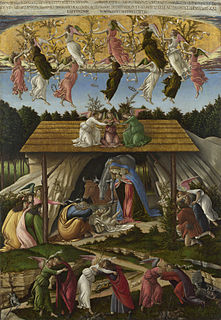 W
WThe Mystical Nativity is a painting dated c. 1500–1501 by the Italian Renaissance master Sandro Botticelli, in the National Gallery in London. Botticelli built up the image using oil on canvas. It is his only signed work and has an unusual iconography for a painting of the Nativity.
 W
WNativity or Rest on the Flight into Egypt is a c.1521-1522 oil on panel painting by Parmigianino, now in the Courtauld Gallery in London.
 W
WNativity is a c.1380 tempera and gold on panel painting by Simone dei Crocifissi, now the only 14th century Bolognese work in the Uffizi in Florence. It is signed "Simon" and – stylistically close to another Nativity – it belongs to the painter's mature period.
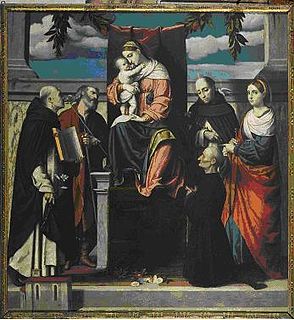 W
WThe Orzinuovi Altarpiece or Enthroned Madonna and Child with Saints Dominic, Joseph, Vincent Ferrer, Lucy and a Commissioner is a 1525–1530 oil on canvas painting by Moretto da Brescia on the wall of the chancel of the church of San Domenico in Orzinuovi.
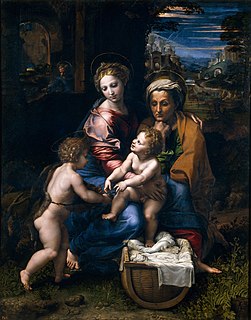 W
WLa Perla is a 1518-1520 oil on canvas painting by Giulio Romano, based on a drawing by Raphael. It shows the Madonna and Child with John the Baptist, St Elisabeth and in the background St Joseph. It is now in the Museo del Prado. It is quite badly damaged and from Giovanni Battista Cavalcaselle onwards it is held to have been painted by Romano after Raphael's death using sketches made by the latter artist - others argue it was painted around 1518. Part of another version has recently been found in the galleria Estense in Modena, known as the Perla di Modena.
 W
WThe Madonna with Child and Saints, also known as Pucci Altarpiece, is a painting by the Italian late Renaissance painter Jacopo Pontormo, executed in 1516. It is housed in the church of San Michele Visdomini in Florence.
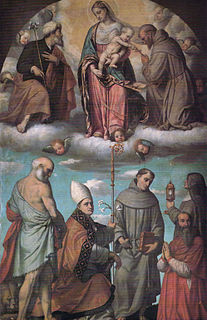 W
WThe Pralboino Altarpiece is a 1540-1545 oil on canvas painting by Moretto da Brescia in the church of Sant'Andrea in Pralboino, Province of Brescia, Italy. The work's upper register shows the Madonna and Child with Francis of Assisi and Saint Joseph, whilst below are saints Jerome, Louis of Toulouse, Anthony of Padua, Clare of Assisi and the painting's commissioner, cardinal Uberto Gambara, member of a local family. It was originally in the same town's Franciscan church of Santa Maria degli Angeli.
 W
WThe Presentation at the Temple is a painting by the Italian Renaissance artist Andrea Mantegna. Dating to c. 1455, it is housed in the Gemäldegalerie, Berlin, Germany.
 W
WThe Presentation at the Temple is a painting by the Italian late medieval painter Ambrogio Lorenzetti, signed and dated 1342, now housed in the Uffizi Gallery of Florence, Italy. It is one of the largest works by the Italian medieval painter, as well as one of the five which he signed and dated.
 W
WPresentazione di Gesù al Tempio is a fresco by Fra Angelico made for the then Dominican Convent of Saint Mark in Florence, Italy. It depicts the dedication of Jesus in the Temple in Jerusalem as the first-born son of His family, as related in the Gospel of St. Luke, 2:23–24. Saint Joseph carries a basket containing two doves as Mary witnesses the Infant Jesus being held by Simeon. This event, the fourth Joyful Mystery of the Rosary, a devotion particularly promoted by the Dominicans, is depicted as being anachronistically witnessed by the Dominican saints Peter of Verona and Catherine of Siena.
 W
WThe Adoration of the Magi is a painting by the Italian painter Gentile da Fabriano. The work, housed in the Uffizi Gallery in Florence, Italy, is considered his finest work, and has been described as "the culminating work of International Gothic painting".
 W
WThe painting of the Purification of the Virgin is a High-Renaissance-style tempera panel piece from an altarpiece painted by Benozzo Gozzoli and once owned by the Compagnia di Santa Maria della Purificazione e di San Zanobi of Florence, Italy. The painting is on display in the Philadelphia Museum of Art in Philadelphia, Pennsylvania, United States of America.
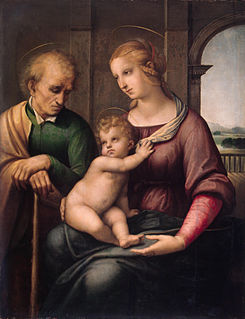 W
WThe Madonna with Beardless St. Joseph is an early painting by Raphael, produced in 1506, now at the Hermitage Museum. It depicts Saint Joseph, the Virgin Mary, and the baby Jesus.
 W
WSaint Joseph is a painting by the Flemish artist Michaelina Wautier, painted some time between 1650 and 1656. It is one of many paintings by Wautier in the Kunsthistorisches Museum, Vienna.
 W
WSaint Joseph and a Devotee is a 1529 tempera on canvas painting on two panels by Correggio, an attribution first proven in the modern era by Ferdinando Bologna in 1957. The panels are mentioned in the 1680 inventories of the Palazzo del Giardino in Parma as a work by Correggio. It is also recorded as such in Giacomo Barri's Viaggio pittoresco, published in 1671. Until the end of the 18th century it featured in Farnese inventories as a work by Corregio. It was probably moved to Naples with the rest of the Farnese collection in 1734 and is now in the National Museum of Capodimonte there.
 W
WSaint Joseph Seeks a Lodging at Bethlehem is an opaque watercolor painting over graphite by James Tissot. The painting was created between 1886-1894, near the end of James Tissot's Career. This style of painting is also known as Gouache.
 W
WThe San Bernardino Altarpiece is a 1521 oil on canvas painting by Lorenzo Lotto, named after the chapel on Via Pignolo in Bergamo, for which it was commissioned by the 'Disciplinati', a lay confraternity. It still hangs in its original position. Lotto also worked on the Santo Spirito Altarpiece at around the same time for the church of Santo Spirito in Bergamo.
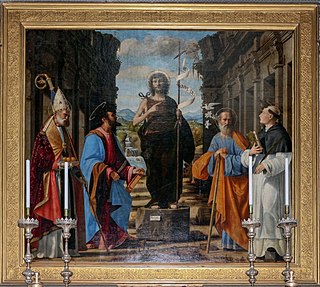 W
WSt John the Baptist with Four Saints or St John the Baptist Among Other Saints is a 1515 oil on canvas painting by Andrea Previtali, displayed in the first side-chapel on the north side of the nave of the church of Santo Spirito in Bergamo, the artist's birthplace. It was the artist's first public commission after his return to Bergamo from Venice.